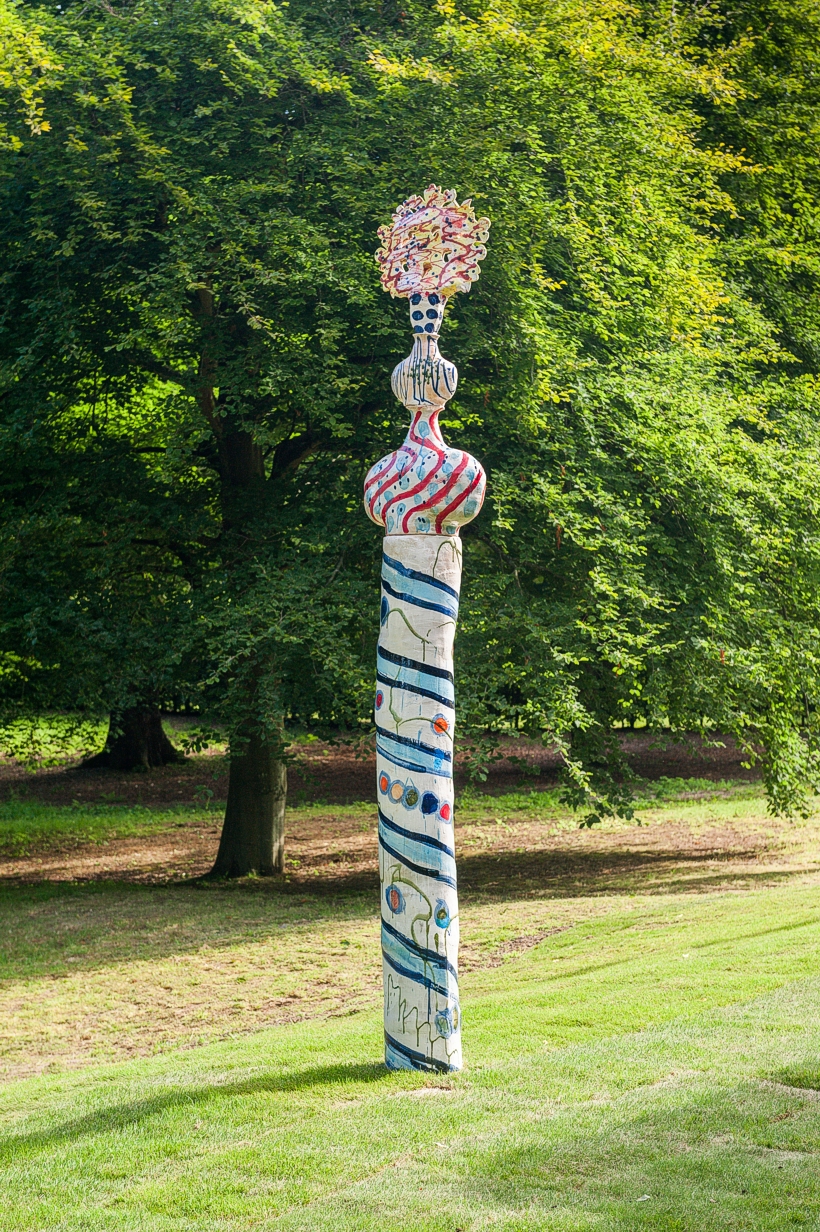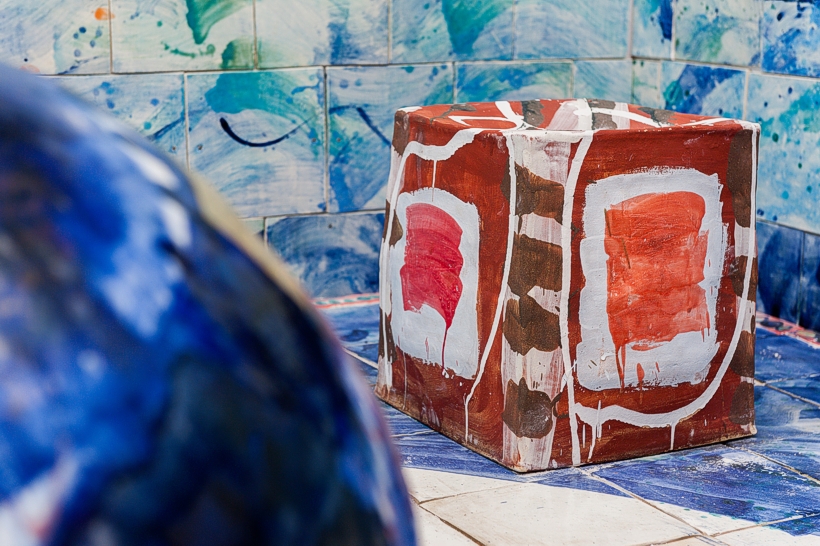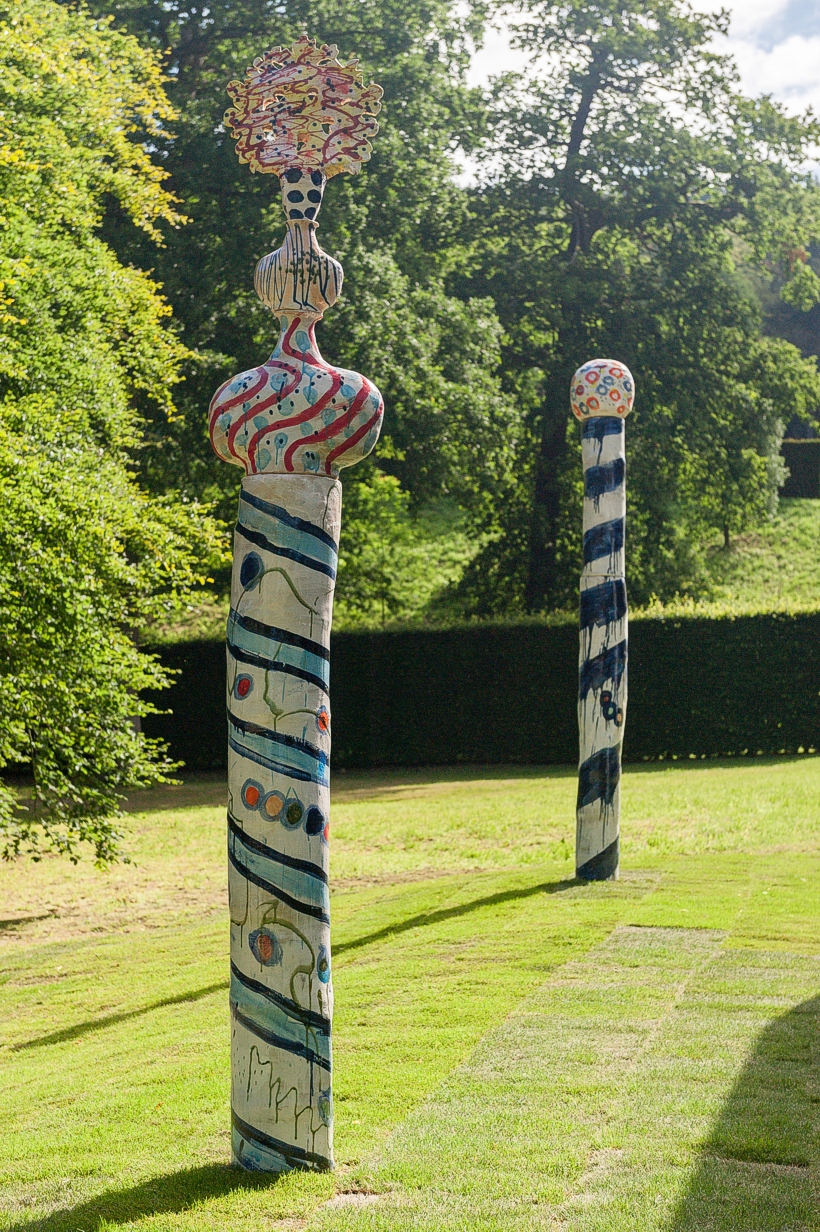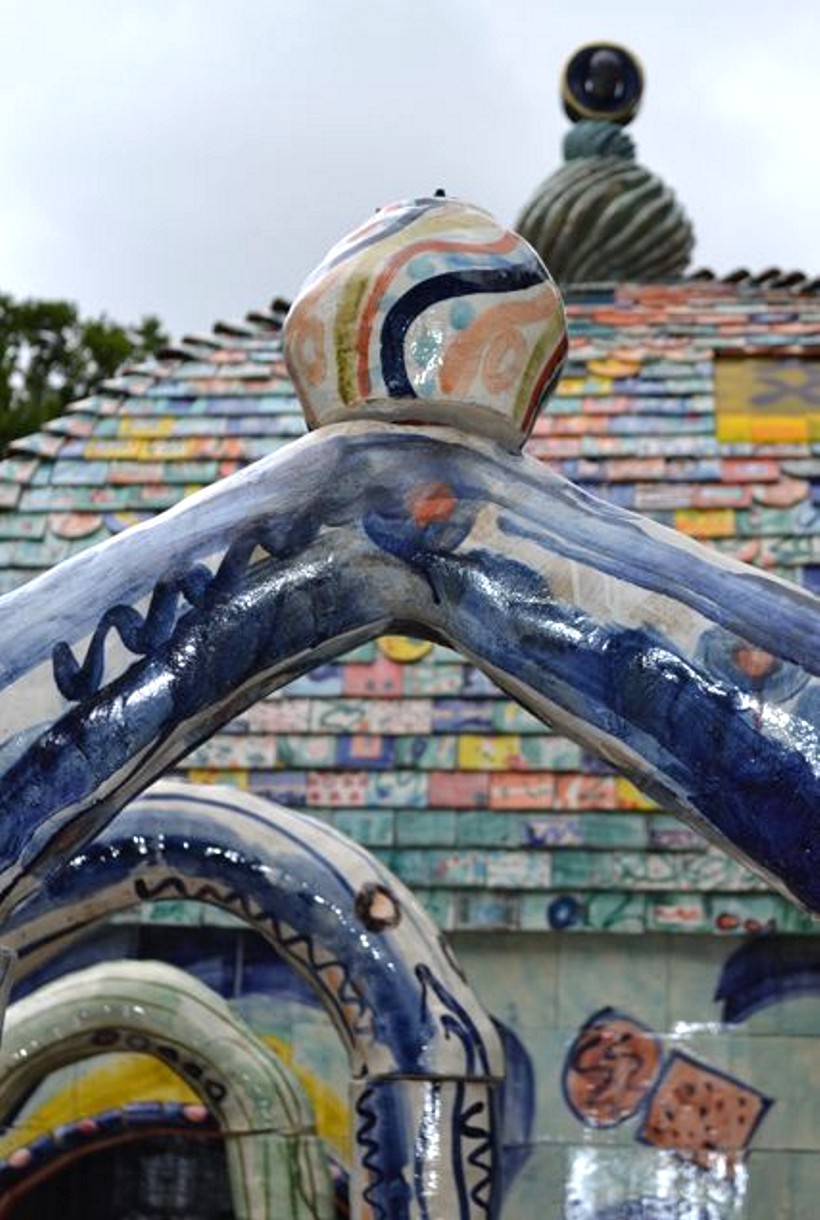TEMPLE
In 2015 Sandy Brown was commissioned by Sotheby’s to create an exciting large scale installation for their Beyond Limits exhibition at Chatsworth House.
Sandy created a magnificent Temple for the exhibition. It is a spiritual non- denominational place for quiet contemplation. For this piece, Sandy was inspired by her visits to Venice, the Taj Mahal, the Blue Mosque in Isfahan, also by Chagall and Matisse. Temple is an expression of joy and free thought, where people may find the opportunity for reflection and inspiration.
Temple stands over 6 metres tall and includes over 5,200 handmade decorated ceramic tiles. It took 11 months to complete and is a major work, with an air of exuberance, colour and vitality. The inside is a riot of colour set off by eight bright fused glass windows by Simon Moore.

Temple ceiling detail


SANDY BROWN TEMPLE
Painted & glazed ceramic tiles,fused glass panels, wood & steel
650 by 400 by 400cm (256" by 157½" by 157½")
Executed in 2015.
This work is unique.
Sandy Brown is one of Britain’s preeminent contemporary ceramicists. Temple was created this year as a temporary installation especially for the gardens at Chatsworth. Involving arches, columns and over 5000 tiles each one painted differently. Temple is an exuberant celebration of colour and creativity. An innovative artist, Brown’s practice has undergone significant development and has in turn made a profound impact on contemporary ceramics. As Gabi Dewald writes: ‘Today it is hard to imagine the European ceramics scene without her. She is famous for her spontaneous, passionate use of clay and colours. Her almost provokingly simple use of form and her strong, energetic brush decorations feed from direct emotion, from confidence in her own intuition and from a portion of childlike anarchy she preserved for herself. Sandy Brown’s catalytic, liberating influence on European ceramics in the seventies and above all eighties must not be underestimated. At a time when European ceramics threatened to get stuck between Asiatic ideals and local traditions, her impetuous, lustful approach to the material demonstrated exciting new possibilities.’
(G. Dewald. ‘Die mondbewegte Frau’. In Keramik Magazin. August-September, 2000).
Inspired by visits to Isfahan, Agra and Venice, Temple’s form is intrinsically linked to its function. As a dazzling counterpoint to the stately elegance of the gardens its idiosyncratic style is an invitation to contemplation and personal reflection. A crucial part of her process in recent years has been her interest in collaboration. Simon Moore provided the fused glass windows which allow soft, coloured light into the sanctum.
Sandy Brown was trained in the art of making ceramics at the Daisei Pottery in Mashiko, Japan. The recipient of Art Council funding, and chosen as Britain’s artist in residence in Australia by the British Council for 1988, Brown has been an important international figure for many years, whose works feature regularly in exhibitions all over the world. Brown’s art is represented by pieces in major public institutions, including the Victoria & Albert Museum, London; Ulster Museum, Belfast; Aberdeen Museum & Art Gallery; the World Ceramic Centre, South Korea and the Museum for Applied Art in Frankfurt.
LITERATURE
Simon Olding. ‘A Temple for the Self’, in Resurgence & Ecologist, September-October 2015, discussed pp. 56-57; photographs of the work in the artist’s studio p.57
Andy Christian, ‘A sanctuary of colour’, in Ceramic Review, November-December 2015 pp.38-41
SANDY BROWN’S TEMPLE: A VIBRANT SENSE OF HOPE
RICHARD CORKE
Viewed from afar, this audacious new art-work may well encourage viewers to regard it as an historic, permanent structure.
As its name suggests, Temple looks at first more like a building than a sculpture. Placed in a verdant setting and framed by four flamboyant columns, along with several stepping-stones and arches leading to the entrance, it immediately triggers memories of architecture which we have encountered elsewhere in the world. But a closer look makes us realise just how much Temple challenges all our notions of a house of prayer. It is perhaps more of a sacred place or a sanctuary, and as if to remind us of dangers in the outside world, a wriggling serpent occupies one window. Sandy Brown has no intention of making her Temple into a denominational centre. Far from it: the 5,200 hand-painted ceramic tiles which make up this extraordinary structure are not dedicated to any religion at all.
Brown’s range of reference is astonishingly wide, and its richness matches the adventurous way in which she brings about an unorthodox marriage between architecture, sculpture, painting, tile decoration and much else besides. The outcome is an exuberant gesamtkunstwerk – a bringing-together of different art-forms in a new composite. It flouts all our expectations as we make our way along the warm coloured stepping-stones, some of them splashed with white and blue. Their freely handled execution defies the tradition of religious formality at every turn. And the arches we walk through, leading to Temple’s entrance, make us aware of vulnerability rather than imposing architectural grandeur.
After moving through a circular aperture, we find ourselves inside Temple. On the floor, surrounded by plate-coloured tiles, a rounded object presides at the centre. This isolated presence is mysterious and unidentifiable. A sense of enigma prevails everywhere in this wildly uninhabited interior, where Brown enlivens most available surfaces with a blizzard of squiggles and splashes. We are invited to sit on two oblong structures, each one installed in a corner. Yet even if we rest on them for a while, our eyes are perpetually invaded by a stream of dynamic and sensuous mark-making. Brown suffered the loss of her husband not long before the Temple project began. So a struggle with bereavement may be felt as we survey the astonishingly rich environment. There is no escape from Brown’s gestural vivacity. Although it could prove overwhelming, she makes sure that a rigorous compositional discipline underlies even the most abandoned passages.
Most of the walls are transformed by circles and squares, evoking windows. But one entire wall is given over to more consistent and rhythmic horizontal gestures, all suggesting a seascape. It feels like a redemptive passage, and the ceiling is alive with a very intense orchestration of curving, undulating and dancing forms. They lead upwards to eight apertures where brightly lit elements, often reminiscent of Matisse’s late painted cut-outs, signal a vibrant sense of hope. Celebrating our natural instinct for survival, they amount to the most climatic area of the entire, every-shifting Temple experience.
At once anarchic, unpredictable, playful, unruly, seductive and enlightening, Brown’s tour de force is inexhaustible. As an artist she demonstrates her bold sense of adventure, embracing the world of line, form and colour to create a haven for visitors. Some of them might find it initially startling, but her free-flowing improvisation will reward anyone who explores this multi-faceted art-work with the open-minded commitment it deserves.






SIMON OLDING SEES A DRAMATIC CERAMIC VISION TAKING SHAPE
Appledore, set elegantly on the edge of the North Devon coast and at the confluence of the Rivers Taw and Torridge, is a village that revels in contrast. White stuccoed villas oversee a working shipyard and a (now empty) dry dock. Sandy Brown’s studio stands out from the grace and magnificence of the river edge with a blast of colour: there is no reticent white here, but vibrant kingfisher colours. The building announces her passion for scale and colour.
And so it is no surprise to find here that Brown has embarked, with her customary zeal, on a project that is magnificent in conception, complex in delivery and dramatic in scale. She calls it Temple. It is built for the purpose of introspection: a Temple for the Self. The building is profoundly extrovert: covered with her hand-painted tiles, inside and out; illuminated internally through handmade glass portholes by Simon Moore. A ceramic serpent writhes across one Gothic window.
This new building, facilitated by Joanna Bird, is for display at Chatsworth House and has been commissioned for the spectacular annual exhibition of contemporary sculpture Beyond Limits (14 September – 25 October 2015). This is a title that might have been conceived with Brown in mind. The project might be traced back to her commanding touring exhibition (2007-9) The Still Point and the Dance, which began, modestly enough, with a passageway through a Japanese tea room, before the explosive drama of totemic ceramic pillars and bold, expressive paintings. Here the tea room established a kind of quietism, a pause and preparation before the vigour of the exhibition to come. It enabled step-change.
Brown has developed this idea of the graduated entrance. The approach to the building is a slow one. The visitor has to navigate stepping stones and pass through three ceremonial arches. We walk in transition. We have to stoop to enter the building through a circular gap designed to curtail onrush. For she wants to slow us down, to emphasise pause; she wants us to focus on the inner and the self in the remarkable site. For all of the focused pace of her glaze painting, the vigour and the swirl of it, the space inside the building is designed for intimate reflection. She wants her Temple to be a “space for contemplation”, a place of rare thought, since “we don’t have in our culture non-denominational or sacred places which are spiritually uplifting”. This is an extrovert place for introvert muse.
The idea of the Temple has been dormant in Brown’s mind for some time. She recalls her travels to Iran as a young adult, and the deep impression made during her visit to the Jameh Mosque in Isfahan, “full of abstract colour”, with its remarkable seven-colour mosaic tiles and calligraphic inscriptions, its dome covered with polychrome tiles giving a sense of spiritual transcendence. Perhaps the domes and finials of Venice, seen in a more recent trip, have enriched the vocabulary of her Temple, too. It makes, say, Beckford’s doomed Fonthill Abby seem almost reasonable. I see this idiosyncratic building wresting the tradition of pavilions sited in the grounds of great country houses into a modern age of cultural reference. This is a serious as well as a playful architecture, like the wonderful Sitooteries (places of private reflection) commissioned by Judith King for Belsay Hall in Northumberland in 2000, or even Grayson Perry’s present-day Essex House, described by Rowan Moore as “like a secular church”.
Brown uses colour and ceramics to vitalise her building: to animate a static place through highly expressive painting and the sheen of her glaze. The building is a symbol of her search for a spiritual moment of peace, and the hope that visitors to the exotic room will find it too. Her Temple shocks the heritage space around it. It glimmers with light bouncing off a thousand individual tiles. The inner walls are conceived as huge tile-panel-paintings; the outer walls are vibrant and spirited, colour bombarding us at every turn. Everything about the project construction is meticulously measured and exact, but this control underpins an exultant sense of freedom and improvisation about the glaze painting. Chance also applies in the way the roof tiles have been randomly placed as they come out of the boxes on site, “forming their own pattern as the Universe dictates”.
This building is a tribute to Brown’s creative energy, her inability to stop still, and her love of challenge. It is a building that is exacting and regulated, eccentric and abandoned, all at once. She has made a place at a scale (four metres square and more than five metres tall) that seems to defy logic, “the biggest thing I have even done”. The confidence of the work and its frenetic order enforce her view “that the abstract is a portal to our thoughts and feelings”. Her Temple is a conundrum: a riot of colour that marks “a space for ourselves and our self”.
The Temple, among other things, helps us to understand the impact of Brown’s studio on the white of Appledore, the vibrant blue punctuating the white stucco. It is an architectural façade shouting aloud in the village, just as this building punctuates the shady bower of Chatsworth. It has helped Brown to think about her own need for restfulness and pause. It is cavalier as well as redemptive. Peace comes in a riot of colour, in the vigour of her painting.
The Temple, as with all of Sandy Brown’s work, “expresses the moment in which it was made”; it is, as she goes on to say, “a dance of clay and glazes”.
Simon Olding is director of the Crafts Study Centre, University for the Creative Arts, Farnham, Surrey.
